
Fortified wine is a wine to which a distilled spirit, usually brandy, has been added. In the course of some centuries, winemakers have developed many different styles of fortified wine, including port, sherry, madeira, Marsala, Commandaria wine, and the aromatised wine vermouth.
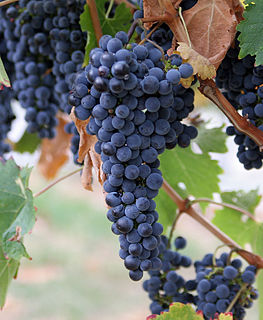
Winemaking or vinification is the production of wine, starting with the selection of the fruit, its fermentation into alcohol, and the bottling of the finished liquid. The history of wine-making stretches over millennia. The science of wine and winemaking is known as oenology. A winemaker may also be called a vintner. The growing of grapes is viticulture and there are many varieties of grapes.
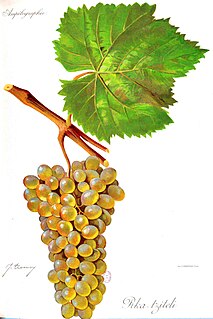
Rkatsiteli is a kind of grape used to produce white wine.

Colombard is a white French wine grape variety that is the offspring of Chenin blanc and Gouais blanc. This makes the grape the sibling of the Armagnac Meslier-Saint-François and the nearly extinct Cognac grape Balzac blanc.

The subjective sweetness of a wine is determined by the interaction of several factors, including the amount of sugar in the wine, but also the relative levels of alcohol, acids, and tannins. Sugars and alcohol enhance a wine's sweetness; acids (sourness) and bitter tannins counteract it. These principles are outlined in the 1987 work by Émile Peynaud, The Taste of Wine.
Hungarian wine has a history dating back to the Kingdom of Hungary. Outside Hungary, the best-known wines are the white dessert wine Tokaji aszú and the red wine Bull's Blood of Eger.

The Missouri Rhineland is a geographical area of Missouri that extends from west of St. Louis to slightly east of Jefferson City, located mostly in the Missouri River Valley on both sides of the river. Dutzow, the first permanent German settlement in Missouri, was founded in 1832 by Baron von Bock. The area is named after the Rhineland region in central Europe, a wine-growing area around the Rhine river, by German-Americans who noticed similarities in the two regions' soil and topography.

Greece is one of the oldest wine-producing regions in the world and among the first wine-producing territories in Europe. The earliest evidence of Greek wine has been dated to 6,500 years ago where wine was produced on a household or communal basis. In ancient times, as trade in wine became extensive, it was transported from end to end of the Mediterranean; Greek wine had especially high prestige in Italy under the Roman Empire. In the medieval period, wines exported from Crete, Monemvasia and other Greek ports fetched high prices in northern Europe.

Meursault is a commune in the Côte-d'Or department and region of Bourgogne-Franche-Comté in eastern France.

Romania is one of the world's largest wine producers and fifth-largest among European wine-producing countries, after Italy, France, Spain, and Germany. Similar in size to wine-producing countries such as Chile and Portugal but lesser-known on the world wine stage. In 2018 it produced around 5.2 million hectolitres of wine. In recent years, Romania has attracted many European business people and wine buyers, due to the affordable prices of both vineyards and wines compared to other wine-producing nations such as France, Germany, and Italy.
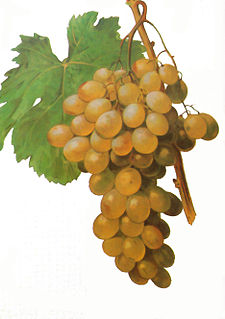
Muscat of Alexandria is a white wine grape that is a member of the Muscat family of Vitis vinifera. It is considered an "ancient vine", and wine experts believe it is one of the oldest genetically unmodified vines still in existence. The grape originated in North Africa, and the name is probably derived from its association with Ancient Egyptians who used the grape for wine making. It is also a table grape used for eating and raisins.

Swiss wine is produced from nearly 15,000 hectares of vineyards, and the wines are mainly produced in the west and in the south of Switzerland, in the cantons of Geneva, Neuchâtel, Ticino, Valais and Vaud. White grape varieties are grown on 43% of the country's vineyard area, and red grape varieties on 57%.

Méntrida is a Spanish Denominación de Origen Protegida (DOP) for wines covering many municipalities in the northeast corner of the province of Toledo and which is divided into three distinct areas: Talavera, Torrijos and Sagra-Toledo, with over 26,000 hectares under vines, the majority (71%) being in Torrijos.

Franconia is a region for quality wine in Germany situated in the north west of Bavaria in the district of Franconia, and is the only wine region in the federal state of Bavaria. In 2014, vines were grown on 6,176 hectares of land in the region.

Saint-Mont is a commune in the Gers department in southwestern France.
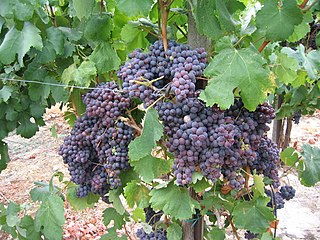
Kotsifali is a red Greek wine grape that is indigenous to the island of Crete. It is mainly grown in the Heraklion regional unit and sporadically on the Cyclades. The grape alone gives moderately red wine with high alcohol content and rich flavor. It is often blended with Mandilaria, yielding a ruby-colored dry wine with pleasant taste and aroma that requires minimal aging.
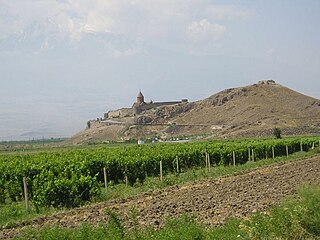
Armenian wine is wine made in Armenia, in the region of South Caucasus. Armenia is one of the oldest wine producing regions of the world. In particular, the oldest known winery was found in Armenia's Areni region, which to this day is still known of its wine production and endemic grapes.
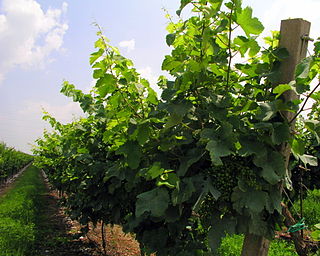
Glera, also known as Prosecco, is a white variety of grape of Slovenian origin, which was brought to the village of Prosecco from the Karst region. The variety was formerly mostly referred to as Prosecco, but in the EU was renamed "Glera" in 2009 to make room for the protection of "Prosecco" as the name of a geographically-protected wine.

Polish wine viticulture and origins have a history dating back to the nation's founding in the tenth century under the Piast dynasty. Like other old world wine producers, many traditional grape varieties still survive in Poland, perfectly suited to their local wine hills. The most popular varieties of grapes for the production of red wine are Regent, Rondo, Pinot Noir, Maréchal Foch, Cabernet Cortis, Tryumf Alzacji, Cascade and Dornfelder. For white wine production, Solaris, Riesling, Seyval Blanc, Pinot Gris, Johanniter, Jutrzenka, Hibernal, Aurora, Bianka, Traminer, Jutrzenka and Siberia are mostly used. Following the Second World War, most wineries were nationalized under the Polish People's Republic communist regime. After the collapse of communism and return to capitalism, the market economy returned, international wine companies moved back in and a period of consolidation followed. Modern wine-production methods have taken over in the larger wineries, and EU-style wine regulations have been adopted, guaranteeing the quality of the wine. Today, wine production in Poland is an industry with 151 officially registered wineries to sell and produce grape table wines in Poland as defined by the national wine laws that came into being in 2008 and were updated later on.

The Albanian wine is produced in several regions throughout Albania within the Mediterranean Basin. The country has one of the oldest wine making traditions, dating back to the ice and Bronze Age whereas Ancient Illyrians inhabited the country's territory some 3,000 years ago. It belongs chronologically to the old world of wine producing countries.


















